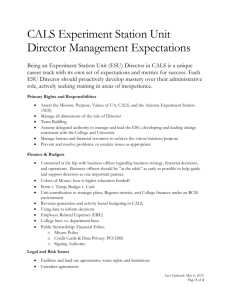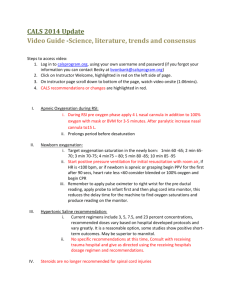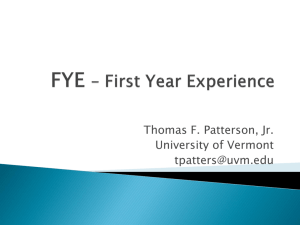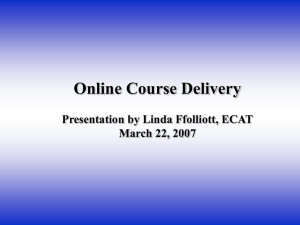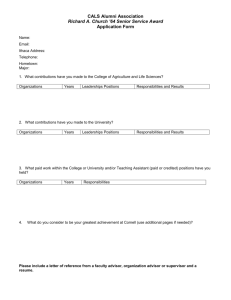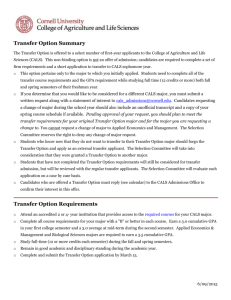Strategic Plan College of Agriculture & Life Sciences CALS Research Strategic Plan
advertisement
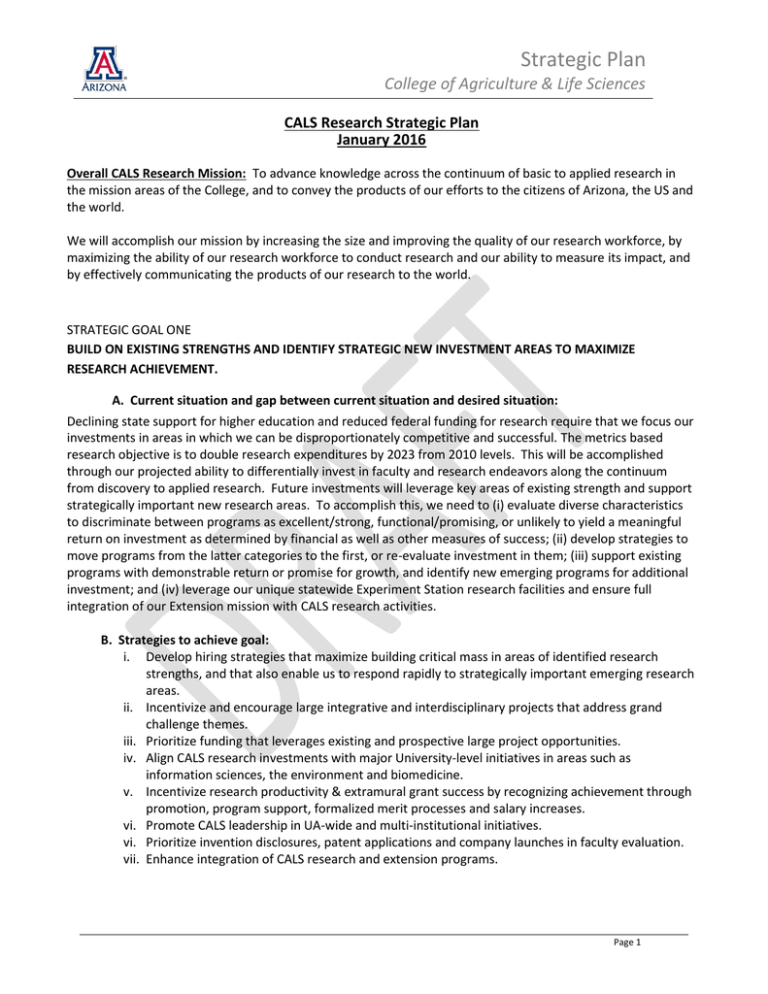
Strategic Plan College of Agriculture & Life Sciences CALS Research Strategic Plan January 2016 Overall CALS Research Mission: To advance knowledge across the continuum of basic to applied research in the mission areas of the College, and to convey the products of our efforts to the citizens of Arizona, the US and the world. We will accomplish our mission by increasing the size and improving the quality of our research workforce, by maximizing the ability of our research workforce to conduct research and our ability to measure its impact, and by effectively communicating the products of our research to the world. STRATEGIC GOAL ONE BUILD ON EXISTING STRENGTHS AND IDENTIFY STRATEGIC NEW INVESTMENT AREAS TO MAXIMIZE RESEARCH ACHIEVEMENT. A. Current situation and gap between current situation and desired situation: Declining state support for higher education and reduced federal funding for research require that we focus our investments in areas in which we can be disproportionately competitive and successful. The metrics based research objective is to double research expenditures by 2023 from 2010 levels. This will be accomplished through our projected ability to differentially invest in faculty and research endeavors along the continuum from discovery to applied research. Future investments will leverage key areas of existing strength and support strategically important new research areas. To accomplish this, we need to (i) evaluate diverse characteristics to discriminate between programs as excellent/strong, functional/promising, or unlikely to yield a meaningful return on investment as determined by financial as well as other measures of success; (ii) develop strategies to move programs from the latter categories to the first, or re-evaluate investment in them; (iii) support existing programs with demonstrable return or promise for growth, and identify new emerging programs for additional investment; and (iv) leverage our unique statewide Experiment Station research facilities and ensure full integration of our Extension mission with CALS research activities. B. Strategies to achieve goal: i. Develop hiring strategies that maximize building critical mass in areas of identified research strengths, and that also enable us to respond rapidly to strategically important emerging research areas. ii. Incentivize and encourage large integrative and interdisciplinary projects that address grand challenge themes. iii. Prioritize funding that leverages existing and prospective large project opportunities. iv. Align CALS research investments with major University-level initiatives in areas such as information sciences, the environment and biomedicine. v. Incentivize research productivity & extramural grant success by recognizing achievement through promotion, program support, formalized merit processes and salary increases. vi. Promote CALS leadership in UA-wide and multi-institutional initiatives. vi. Prioritize invention disclosures, patent applications and company launches in faculty evaluation. vii. Enhance integration of CALS research and extension programs. Page 1 Strategic Plan College of Agriculture & Life Sciences C. Actions Implement hiring strategies to promote the following: a) achieving critical mass in areas of research strength; b) responsiveness to emerging research needs; c) hiring at all rank levels; d) immediate and long term return on investment; e) research across the continuum from discoverybased to applied research. Coordinate with university-wide initiatives to build integrative research centers and programs. Institute merit-based reinvestment packages at year 6 faculty reviews and at mid career for highly productive scientists. Establish bridge-funding mechanisms to temporarily maintain successful grant-funded programs that have had adverse grant funding decisions, and pilot funding mechanisms to stimulate new and innovative research efforts with promise for significant programmatic growth. Encourage and incentivize the use of CALS unique research assets (Ag Centers) to build programs that address mission-based grand challenges. Recognize research excellence through CALS awards, and ensure that CALS faculty are nominated for University-wide, regional, national, and international awards, and strategically important national committees and advisory boards. Integrate with Tech Launch Arizona to educate faculty and staff about technology transfer opportunities and processes, to maximize submission of invention disclosures and patent applications, and launch of startup companies. D. Inputs Needed to Achieve Goal Cooperation with Unit Heads to coordinate hiring objectives with overall CALS strategies and goals. Allocation of CALS internal resources to ensure dedicated support for research initiatives and to maximally support and incentivize CALS research programs. Coordination of CALS research investments and activities with research strategies of the University, the state of Arizona, and the Nation. Support for CALS faculty in priority research areas with potential for high return on investment. E. Objective metrics that will be used to track progress towards attaining goals Upward trends in number of grants awarded, total research dollars, publications, CALS-led multiinvestigator grants, and additional metrics that measure research impact. Upward trends in total impact and impact per faculty member. Trending increases in invention disclosures, patents and startup companies. Identifiable and measured contributions by CALS to improved economic and social conditions in Arizona. Page 2 Strategic Plan College of Agriculture & Life Sciences STRATEGIC GOAL TWO OPTIMIZE CALS RESEARCH INFRASTRUCTURE TO SUPPORT THE CALS RESEARCH MISSION A. Current situation and gap between current situation and desired situation: Cultural and structural changes over the past two years have improved CALS Research Office functions. Improvements include: i) reorganization and efficiency improvements in all facets of CALS pre award activities; ii) employing the most qualified people available to perform pre award services; iii) Implementation of training programs for faculty and staff in grant preparation and submission processes; iv) Streamlining the Federal Capacity Funds grant program internal application and reporting mechanisms to improve staff efficiency and reduce the overall burden to faculty and staff; v) Integration with University-wide processes to improve project pre and post award activities; vi) Rationalization of cost share and waiver policies, resulting in the virtual elimination of both activities; vii) In collaboration with the CALS Data Solutions Team, streamlining and rationalization of CALS reporting systems, leading to improved efficiencies and data availability; viii) Cultural transformation in the CALS Research Office from a focus on monitoring and rules enforcement to one focused on service and enablement. This first phase of transformation has “reduced the friction” and optimized processes, thereby increasing the ability of faculty and staff to pursue their research objectives. Improvements are now needed in the following areas: 1) Research Infrastructure: The quality of the physical research infrastructure (laboratories and large equipment) is highly variable across college units and buildings. The physical infrastructure of all units must be updated to be on par with or exceed that of our peer colleges and institutions. 2) CALS Experiment Station Facilities: Strategic planning efforts have begun to align our statewide research facilities to overtly support the overall CALS research mission. This process must continue to determine how these unique research facilities can best directly support research of CALS faculty and staff, and/or provide significant value to stakeholders that is strategically significant to CALS and the UA. 3) Graduate Education: As the training environment for future scientists and also the source of our most important research workforce, CALS graduate programs must be uniformly strong and competitive with programs at the best US and international institutions. Sustained budget reductions have reduced funds available for graduate student support while also reducing the number of research faculty. Combined with structural changes to graduate education, these issues have proven highly challenging for most CALS graduate programs. Stipends have fallen far below national averages, and for some programs recruiting has become less competitive. This has had a negative impact on completion rates and times to degree, and on the quality of research conducted in faculty labs. 4) Research Data and Metrics: Working with the office of the Associate Dean for Finance and Administration, significant improvements have been made over the past two years in data quality and availability. Despite these advances, the quality and availability of research-related data information remains suboptimal to support real time analysis and informed decision making. B. Strategies to achieve goal i. Develop a comprehensive plan for upgrading CALS research space and facilities. ii. Develop a strategy for renewed investment in and revitalization of CALS graduate programs. iii. Ensure optimal training for faculty and staff in all grants and contracts pre and post award related activities. iv. Identify data and metrics that will maximally enhance real time analysis and research strategic planning. v. Develop strategies for utilizing CALS unique research facilities (Ag Centers etc) and integrating with hiring decisions. Page 3 Strategic Plan College of Agriculture & Life Sciences C. Actions Evaluate all CALS research space and develop a multi year strategy for infrastructure upgrades. Engage relevant stakeholders to develop a comprehensive strategic plan for providing long term financial and operational stability to CALS graduate programs. Identify data needed to maximize research related activities and analysis, and assist in developing appropriate presentation mechanisms. Define the value of each Experiment Station Research Facility to the CALS Research and Extension mission, and encourage the integration of these facilities into unit research strategic plans. D. Inputs needed to achieve goal Engagement of CALS graduate program leaders, unit heads and faculty concerning the future of CALS graduate programs. Engagement with UAIR and CALS Data Solution Team Engagement of unit heads, Experiment Station Facility Directors, and extension directors. E. Objective metrics that will be used to track progress towards attaining goals Incremental upgrading of substandard research space. Increase in graduate student recruiting and stipend levels; reduction in average time to degree. Increased research activity associated with Experiment Station Facilities. Page 4 Strategic Plan College of Agriculture & Life Sciences STRATEGIC GOAL THREE DEFINE AND MEASURE RESOURCE GENERATION FOR RESEARCH A. Current situation and gap between current situation and desired situation: The metrics based research objective is to double research expenditures by 2023 from 2010 levels. Although ABOR benchmarks track grants and contracts dollars, additional measures of scholarship productivity are relevant to measuring the total impact of CALS research. Relevant metrics include: number of Masters and PhD degrees; publications and impact factors, faculty and team awards, contribution to complex projects involving teams of scientists; invention disclosures, patents, and startup companies. A calculation of return on investment (ROI) is another important measure of our impact relative to investment. These objectives will be pursued in collaboration with the Associate Dean for Finance and Administration. Coming to consensus on metrics that best define success, collecting the metrics in an accurate and timely manner, and providing stakeholder access is an important component of our ability to strategically pursue research that maximally impacts the citizens of Arizona, the US and the world. B. Strategies to achieve goal Use ABOR and UA metrics, plus additional CALS-defined metrics, to measure and track research i. productivity. ii. iii. iv. v. vi. Identify measures of success and impact beyond funds received and expended, and incorporate these measures into individual, unit and college level evaluations. Ensure that accurate data are available in real time through online resources, including UAccess dashboards. Calculate, track and use for evaluation purposes return on investment (ROI) for individual faculty and units. Define, track and use for evaluation purposes measures of success for CALS Experiment Station research facilities. Ensure robust training for faculty and staff in the collection and use of research metrics. C. Actions In consultation with faculty, Unit Heads, and other stakeholders, identify a suite of metrics to measure, track and evaluate research performance. Work with UAIR, the CALS Data Solutions Team and the CALS for Finance and Administration to implement optimal online data reporting mechanisms. Review and optimize existing CALS training programs to provide CALS personnel with data needed for performance evaluations and research strategic planning. Work with Unit Heads, Experiment Station Directors, Associate Deans and other stakeholders to define metrics that measure productivity of the Experiment Station research facilities. Identify strategies to strengthen the connection between Research and Extension programs. D. Inputs needed to achieve goal Broad input (faculty; HODs, CEDs; DRAC; Dean’s Council) and agreement on priority metrics. Input on best metrics for ROI calculations in programs across CALS. Flexibility for incentives / rewards for individuals and teams / units that have high ROI. Objective metrics that will be used to track progress towards attaining goal • CALS units (including college level Associate Deans-Research, Extension, Instruction, Page 5 Strategic Plan College of Agriculture & Life Sciences Administrative Services) will have clearly identified metrics and tracking for research productivity and resource generation. • • Data will be available to properly assess the contribution of CALS Experiment Station Research Facilities to the overall research mission. CALs faculty and staff will be familiar with and able to evaluate research metrics. Identifiable and measured contributions by CALS to improved economic and social conditions in Arizona. Page 6 Strategic Plan College of Agriculture & Life Sciences STRATEGIC GOAL FOUR: EXPAND COMMUNICATION ON RESEARCH ACTIVITIES A. Current situation and gap between current situation and desired situation: Communication of research activities and outcomes are a key part of the CALS research mission “…to convey the products of our efforts to the citizens of Arizona, the US and the world.” The Internet has transformed communications activities by dramatically increasing the quantity of information disseminated, the timeliness with which information is received and the diversity of communication mechanisms. With increasing competitiveness for research resources and the attention of key stakeholders, communication about our ongoing efforts and research findings is becoming increasingly important to our research mission. Expanded communications are needed internally within CALS and externally to our various stakeholders. This is critical for promoting our research strengths and for the developing new collaborative projects and identifying extra-CALS partnerships. Presently the CALS Communications Office provides media coverage for all College endeavors, leaving insufficient resources for research communications. Particularly with the multitude of ways that science can now be communicated, additional resources are needed to expand communications related to ongoing and completed research. Improved internal communications are needed highlight research strengths among CALS faculty, while external communications are needed to promote our research activities to the public, other scientists, federal and private research entities, and potential donors. A focused effort is needed in the state of Arizona to highlight our achievements to the public, legislators, other government officials, and higher education stakeholders including ABOR. B. Strategy: i. Increase our capacity to communicate ongoing research activities and research findings using all available platforms to stakeholders within CALS and the UA, and externally to a variety of stakeholders. ii. Use increased communications to raise the profile of CALS research locally, statewide, nationally, and internationally. iii. Develop a strategy to target industry sectors of relevance to CALS research activities. C. Actions Develop a comprehensive communications strategy for CALS research that encompasses all means of communication. Develop a comprehensive social media presence for CALS research. Invest the resources necessary to implement the communications strategy. Coordinate events that highlight areas of excellence in CALS to stakeholders in Arizona. Identify and publicize projects that are supported by strategic investments from development sources and that leverage state investments. Integrate with communication activities at the UA to assist with information placement through UA venues. D. Inputs needed to achieve the goal Resources to expand research communications capabilities. A comprehensive CALS research communications strategy. E. Objective metrics that will be used to track progress towards attaining goal Increased number of media placements; increased social media activity related to CALS research. Increased awareness by all stakeholders of CALS research activities. Page 7 Strategic Plan College of Agriculture & Life Sciences STRATEGIC GOAL FIVE: BUILD TECH TRANSFER, IP DEVELOPMENT, EXTERNAL BUSINESS RELATIONS/DEVELOPMENT A. Current situation and gap between current situation and desired situation: Maximizing the transfer of knowledge and inventions to the private sector is a core University mission. The UA established Tech Launch Arizona (TLA) to strengthen its technology transfer and business development capabilities, and to enhance the impact of UA research, intellectual property (IP) and technology innovation. Similarly, CALS goals are to maximize the ability of faculty and staff to move their research knowledge and inventions to the private sector, and also to create and sustain industry partnerships. Effectiveness of these activities are measured using ABOR designated metrics: invention disclosures, US patents issued, IP revenue, and new companies started. Although CALS has begun to take advantage of the new capacity provided by TLA, including a TLA licensing manager focused on CALS, we do not yet have a strong culture of encouraging and rewarding disclosures, tech transfer and business development. Furthermore, effective mechanisms have not yet been defined for creating and sustaining industry partnerships. B. Strategies to achieve goal: i. Embed technology transfer, business development training and informational workshops into existing CALS faculty and staff training programs. ii. Develop strategies and processes to enable and sustain industry partnerships. iii. Establish clear faculty performance criteria so that technology transfer activities and business relationships are rewarded in the promotion and tenure process. iv. Add entrepreneurship to faculty and staff position descriptions. C. Actions Improve and update existing training modules and workshops for CALS faculty and staff. Provide mechanism(s) to support entrepreneurial initiatives proposed by CALS faculty. Review promotion and tenure criteria to ensure full consideration of entrepreneurial activities in faculty career progressions. Identify and nurture industry partnerships. D. Inputs needed to achieve the goal Cooperation and time of contracting units to develop more efficient mechanisms for establishing and maintaining industry partnerships and support of UA research. Faculty time and interest to attend workshops. Improved and more transparent reporting of progress on ABOR approved metrics. E. Objective metrics that will be used to track progress towards attaining goal Upward trends in the number of disclosures, patent applications, patents awarded and companies launched. Number of faculty reporting patent/IP/other entrepreneurial productivity Increases in contracts and other relationships with industry partners. Workshop attendance and interest in IP/contracting activities by faculty and staff. Page 8
